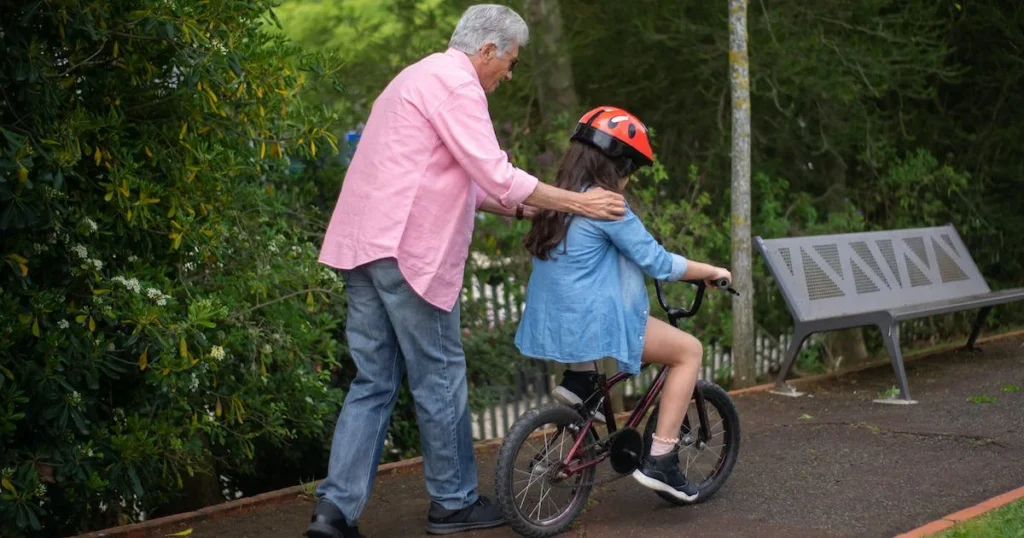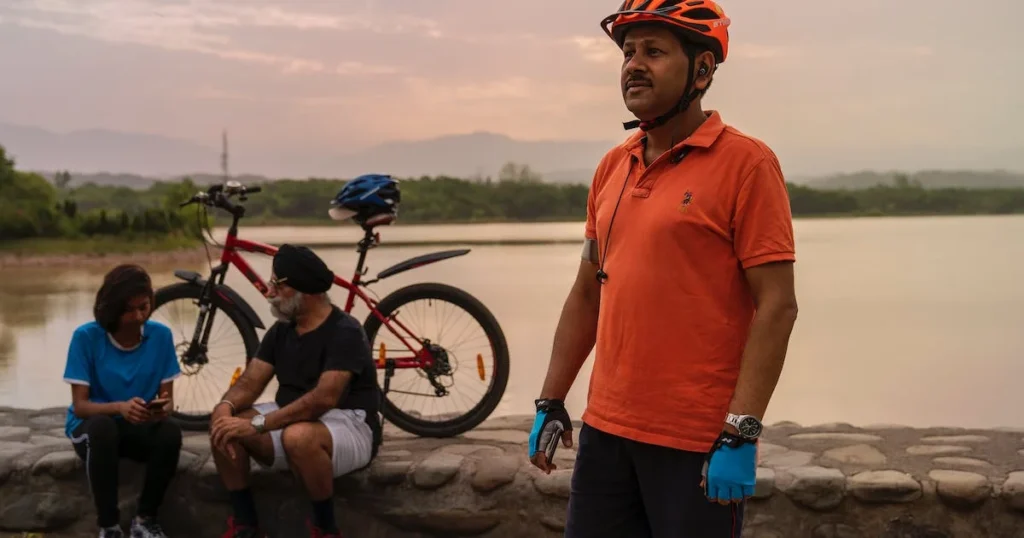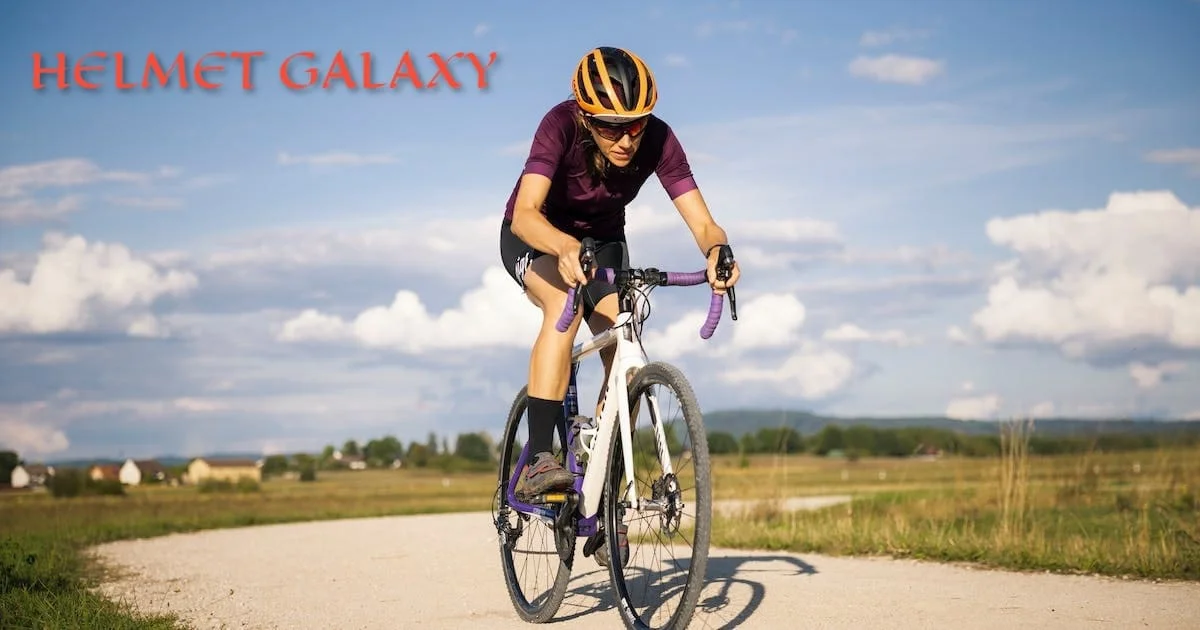Riding a bicycle can be a fun and healthy activity for people of all ages. However, it also carries some risk of injury if proper safety precautions are not taken. One of the most important safety measures when riding a bike is wearing a helmet. Helmets have been shown to dramatically reduce the risk of head injury in the event of an accident.
But who exactly is required by law to wear a helmet when cycling? And what are the recommendations for helmet use even when not legally mandated? This article will examine helmet laws and recommendations to help clarify who should wear a bike helmet.
Helmet Laws for Children

Navigating helmet laws for children is crucial for their safety on two wheels. Understanding the age-specific regulations ensures parents can confidently enforce proper head protection, creating a secure biking environment for the younger riders.
Overview of Child Helmet Laws
Many jurisdictions have laws requiring bicycle helmets for children of certain ages. These laws recognize that children are at higher risk for bicycle injuries and that helmets can greatly reduce morbidity and mortality.
According to the Insurance Institute for Highway Safety (IIHS), there are currently 21 states and the District of Columbia that have youth bicycle helmet laws. Let’s take a look at some of the most common provisions of these laws.
Typical Age Requirements
Most child helmet laws apply to bicyclists under the age of 17 or 18. For example, Florida’s helmet law covers any child under age 16. New York’s law applies to children age 14 and younger. Some states phase in the helmet requirement over a couple of years. In Texas, the law applies to bicyclists under age 18, but there is no penalty for non-compliance for children ages 10-16.
Typical Penalties
Most child helmet laws impose penalties on the child’s parent or guardian if they fail to ensure the child wears a helmet. Fines for a first offense are generally around $10-25, with higher fines for subsequent violations. Some laws impose small fines directly on older children who violate the statute.
Along with fines, some jurisdictions impose modest court fees on violators. The purpose is not to strictly punish families, but to strongly encourage helmet use through legal requirements.
Exemptions
Some states exempt certain cyclists from their youth helmet laws. For example, many states do not require helmets where religious beliefs prohibit them. Some states also exempt children when they are riding on private property or in designated bike lanes.
And most laws exempt youth riding non-moving bikes detached from a motor, like a tricycle. Any exemptions that apply should be detailed in the specific state law.
Enforcement
Police enforcement of youth helmet laws varies across jurisdictions, but is generally not stringent. Officers may stop and warn children and/or their parents when observed riding without a helmet. Formal citations are not as common, especially for younger children. Like seatbelt laws for motor vehicles, the priority is increasing public awareness and voluntary compliance.
Adult Helmet Laws

Far fewer jurisdictions have bicycle helmet laws applying to adults. According to the Bicycle Helmet Safety Institute (BHSI), only 4 states have broad laws requiring helmets for adult cyclists:
- Massachusetts
- New Jersey
- Delaware
- Hawaii
Some cities also have municipal ordinances mandating helmet use by all riders regardless of age, like Seattle, WA. Beyond these limited locations, most states do not legally require adults to wear helmets. However, many experts still strongly advise using helmets for safety reasons.
Typical Requirements
Where mandatory helmet use laws for adults exist, they generally apply to all riders over a specified age on any public roadway. For example, New Jersey’s statute covers persons age 17 or older, while Hawaii’s includes all cyclists over age 15. Most adult helmet laws impose modest fines for noncompliance similar to child helmet laws, but exempt young children from penalties.
Exemptions
Adult bicycle helmet laws provide similar exemptions as those for youth, including medical and religious reasons. Hawaii allows exemptions for bike tour participants provided they sign a waiver. Some statutes also exempt adults riding on sidewalks, private property, or bicycle paths. Enforcement tends to be minimal for adults.
Arguments For and Against
Proponents argue that adult helmet laws promote safety and mirror seat belt requirements for motor vehicles. Critics contend that adult cyclists should be able to choose whether to wear a helmet given bikes pose less risk to others compared to cars.
Some also claim mandatory helmet laws deter bike ridership, which offsets public health benefits from more exercise. The limited number of jurisdictions with adult helmet laws reflects these ongoing pros and cons debates.
Helmet Recommendations for All Cyclists

For cyclists of all ages, adhering to helmet recommendations is a non-negotiable aspect of responsible biking. From casual riders to seasoned enthusiasts, embracing headgear guidelines ensures a safer and more enjoyable journey on every cycling adventure.
Safety Organizations Strongly Advise Helmet Use
Many safety agencies and organizations involved in public health, medicine, and injury prevention actively encourage all bicyclists to wear bicycle helmets, even where not legally mandated. These groups recognize the proven effectiveness of bicycle helmets in reducing head injuries.
For example, the National Highway Traffic Safety Administration states that bicycle helmets save lives by decreasing the risk of head injury by as much as 85%. The American Academy of Pediatrics (AAP) recommends bicycle helmet use for all children and advocates for universal laws requiring bicycle helmets for cyclists under 18.
The AAP also stresses that adults should set a good example by wearing bicycle helmets when cycling. Similar policy statements urging bicycle helmet use for all ages have been issued by groups like Safe Kids Worldwide, the American Medical Society, and many others.
Helmet Use Encouraged Even Where Not Legally Required
In areas without bicycle helmet laws for adults, many health and safety experts still strongly encourage their use. Wearing a helmet is considered an important injury prevention measure and safe cycling practice regardless of legal mandates.
Some evidence suggests that the passage of youth helmet laws increases use among adults by reinforcing the importance of helmets. But public health campaigns emphasize that adults should wear helmets to protect themselves and set an example, whether or not they are legally required for their age group.
Experts recommend that all cyclists wear properly fitted and certified helmets anytime they ride, even on short trips. They advise helmet use is especially important on roads with motor vehicles present, but that riders should consider wearing one even on bike paths or sidewalks due to risks of injury. Consistently choosing to wear a helmet helps promote it as a social norm.
Factors in Helmet Use Recommendations

The key reason health and safety advocates strongly recommend wearing bicycle helmets is their proven ability to reduce the risk of head injuries. Analysis of medical studies has found that helmets decrease the odds of head injury by nearly 70% compared to not wearing one.
Head injuries are a major contributor to bicycle-related deaths and disability. Helmets protect the skull and brain by absorbing force and impact from falls or collisions. Unhelmeted riders are much more prone to serious injuries like fractures, concussions, traumatic brain injury (TBI), and hemorrhage. These can lead to short-term disability or even permanent impairment. Consistent helmet use is among the easiest ways cyclists can lower their injury risk.
Vulnerability of Child Cyclists
Children and adolescents who ride bikes are universally recommended to wear helmets due to their increased vulnerability. Children have higher rates of bicycle injuries compared to adults and are more prone to serious head trauma.
Younger children in particular have less developed motor skills and ability to gauge road hazards. Kids also cannot fully predict or identify dangers, so rely on caregivers for safety guidance. Helmet use is an easy precaution parents can take to protect their children. Pediatric health organizations strongly encourage bike helmet laws to reinforce their use among youth.
Possibility of Accidents Even on Local Roads
Another reason experts advise wearing helmets for any bike trip is that accidents can occur even close to home. While risk may seem lower on side streets and local roads, falls and collisions are still possible due to hazards like potholes, debris, pets, or opening car doors. Studies have found most cycling head injuries actually happen on neighborhood roads rather than highways. So helmets are recommended regardless of trip length or location.
Modeling Safe Behavior for Children
When adults wear bike helmets regularly, it reinforces the importance of this precaution and sets a safety-conscious example. Parents and caregivers can model good behavior by always wearing a helmet when cycling with children or nearby areas.
Seeing adults consistently choose to wear helmets helps normalize them as standard safety gear rather than something reserved only for kids. Role modeling is a key way adults can promote safe practices.
Simple Precaution with Major Injury Prevention Benefits
Ultimately, wearing a bicycle helmet is a simple, inexpensive and pragmatic way for cyclists of any age to reduce injury risks. Persistently choosing to wear one every ride encourages it as an automatic safety habit.
People would not consider driving a car without a seatbelt or allow a child to ride unrestrained. Helmets provide an analogous level of protection for bike riders against preventable head trauma. As such, use by all ages is highly recommended by experts even where not legally mandated.
Conclusion
Wearing a properly fitted bicycle helmet is one of the simplest and most effective ways cyclists of any age can protect themselves against head injury. There are currently only limited jurisdictions that legally require helmet use by adult riders. However, numerous public health and safety organizations strongly recommend wearing helmets anytime you ride, even where not mandated by law.
Helmets have been conclusively proven to dramatically reduce the risk and severity of head trauma in the event of an accident. By persistently wearing a helmet whenever you ride, you are taking a pragmatic preventive measure to lower injury risks and setting a safety-conscious example for children. Experts agree that bicycle helmets should be standard protective gear used by all cyclists regardless of age or legal requirements
Frequently Asked Questions About Bicycle Helmet Laws and Recommendations
Who is legally required to wear a bicycle helmet?
Currently 21 states and DC legally require bicycle helmets for children and youth under ages ranging from 16 to 18. Just 4 states (Massachusetts, New Jersey, Delaware and Hawaii) have helmet laws that also cover adult cyclists. Some local jurisdictions also mandate helmets for all ages through municipal ordinances.
What are the penalties for violating youth bike helmet laws?
Most laws impose small fines, generally $10-25, on the parents of children caught cycling without helmets. Some also have modest fines for older children who violate the statute. The main purpose is to promote awareness and compliance rather than strictly punish violators.
Do bike helmet laws apply on sidewalks or bike paths?
Most states exempt cyclists riding on private property or off-road bike/recreation paths from helmet mandates – check your specific state law. However, experts still recommend wearing helmets on any surface given injury risks from falls.
Can you get out of wearing a bike helmet for medical or religious reasons?
Yes, most mandatory helmet laws exempt people whose religious beliefs prohibit helmet wear or who cannot wear one for medical reasons. However, cyclists are encouraged to wear alternative protective headgear if possible.
Do experts recommend helmets even where not legally required?
Yes, agencies like the NHTSA, AAP and many others strongly advise wearing appropriate helmets for all ages anytime you ride a bike for optimal safety, even when not mandated. They provide proven injury prevention benefits.
Does my homeowner’s insurance cover bike accidents if I wasn’t wearing a helmet?
Most policies do not exclude injuries sustained while cycling without a helmet, but you should check your specific policy. Discounts may apply if you can prove you regularly wear a helmet when riding. Always truthfully disclose your helmet use.
Do I need a helmet for casual neighborhood riding?
Safety experts recommend wearing a helmet on any bike trip, even around local areas. While risk seems lower on side streets, most cycling accidents and injuries actually occur close to home rather than highways. Helmets protect against head impacts in any location.
Can I be liable if my child rides without a helmet?
You may face modest fines under youth helmet laws if you allow your child to ride unhelmeted, though enforcement is not aggressive. More importantly, not ensuring your child wears a helmet greatly increases their risk of preventable injury. Parents are responsible for protecting their children.
How can I get my child to cooperate with wearing a helmet?
Make it fun by letting them customize the helmet with stickers. Have them wear it while stationary to get used to it. Praise and reward them when they put it on without fussing. Most importantly, be a role model by always wearing your own helmet when cycling with them.
